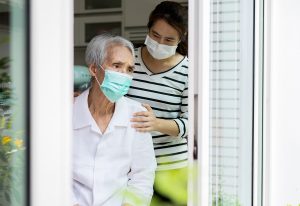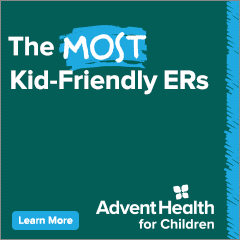Protecting the Vulnerable
Long-term care communities in Florida remain dedicated to providing the utmost care to the elderly at-risk population.
 During any emergency, the care and safety of the aging generations are among the top priorities. Those who have devoted their lives and careers to this population treated the COVID-19 pandemic with as much urgency as they would a hurricane, however, the ever-changing understanding of the virus meant plans could change with a moment’s notice. Health care workers and the organizations that support them stepped up in ways that went well beyond their job description. Orlando Family Magazine spoke to organizations that have been working with assisted living and nursing home facilities, providing guidance and advocacy throughout the pandemic, and as the holiday season approaches, they say vigilance is key to reduce risk of infection.
During any emergency, the care and safety of the aging generations are among the top priorities. Those who have devoted their lives and careers to this population treated the COVID-19 pandemic with as much urgency as they would a hurricane, however, the ever-changing understanding of the virus meant plans could change with a moment’s notice. Health care workers and the organizations that support them stepped up in ways that went well beyond their job description. Orlando Family Magazine spoke to organizations that have been working with assisted living and nursing home facilities, providing guidance and advocacy throughout the pandemic, and as the holiday season approaches, they say vigilance is key to reduce risk of infection.
As a particularly vulnerable group, residents of long-term care communities were some of the first to see a significant change in their normal routines, which included no visitation from family beginning in early March.
“The majority of residents accepted the need to be away from their loved ones for their own medical well-being, however, it is emotionally draining for them to be without personal touch,” says Veronica Catoe, CEO of the Florida Assisted Living Association (FALA). “Visual communication fills the gap, but it does not replace physical touch. Not only have residents been isolated from their families, they also have been isolated from their neighbors. Everything about their home has changed, including the way they eat in the dining room with their peers, having to wear a mask and not having outside entertainers.”
Organizations like FALA, which represents more than 650 assisted living facilities and adult family care homes in Florida, were crucial in helping members remain compliant with Department of Health and Centers for Disease Control and Prevention (CDC) guidelines. “FALA has answered thousands of phone calls from members with questions ranging from newly implemented protocols to procedures for specific residents returning to the facility from the hospital. We have made many, many outgoing calls in collaboration with the Agency for Health Care Administration to licensed facilities at times to increase their compliance with state reporting requirements and have assisted with the state’s planning efforts for vaccine distribution,” Catoe says.
Not only was information a valuable commodity as more was learned about the coronavirus, so was personal protective equipment (PPE). Kristen Knapp, director of communications for the Florida Health Care Association (FHCA), a statewide trade association representing 82% of Florida’s nursing centers ranging from skilled nursing and post-acute and sub-acute care, to assisted living, says PPE was essential to preventing the spread of COVID-19, but it was not something regularly on-hand.
“These facilities are not hospitals, but they are caring for the vulnerable population 65 and over with underlying conditions,” she says. “With the global and national shortage of PPE, there was a focus on supplying hospitals first and we worked with the state and federal government to raise awareness of our [members’] need for PPE.”
However, all of these extra measures came at a huge cost, Knapp adds. “Medicaid reimbursements already don’t cover the costs of providing care, which means facilities’ expenses skyrocket—PPE, infection control supplies, heroes pay/overtime for workers, testing; and revenues are down due to declining occupancy rates, [as a result of] no elective surgeries, no snowbirds traveling to Florida, etc.” The CARES Act has helped provide relief to many within the industry.
Despite their efforts, there is still some frustration in the long-term care industry, which was often targeted in the media for reporting its outbreaks of infection. These were not a sign of a lack of care inside these communities, Knapp says. “Research shows that outbreaks in nursing homes are indicative of community spread,” she says. “We’ve learned you can be asymptomatic and be positive. Our staff had lives to live—they went home to their families, grocery shopped. Mask mandates are helping, but back in June there was no mandate. I think now more people recognize that wearing a mask protects you from me. … Ultimately, none of us had a playbook for this, and our members were operating with limited resources while protecting residents and I’m really proud of them.”
Both Catoe and Knapp point out the lengths to which long-term care staff have gone since the pandemic began.
“Facilities truly have risen above to help residents and staff stay safe,” Catoe says. “Communities have created outdoor spaces and set up visitation rooms, as well as implemented requirements from state and federal guidelines that weren’t in place before, including enhanced cleaning and infection control procedures. There initially was public concern that caregivers would no longer come to work, but staff members have continued to show up for their communities. Many staff members have totally changed their way of life, both at the facility and outside of the community. Staff members are limiting interactions with their own families, taking fewer trips to the store and limiting non-essential activities in order to minimize their risk of exposure to protect those they care for.”
Knapp says she’s seen amazing acts of humanity in the face of these challenges. “Communal dining was stopped and we saw staff—even those on the administrative level—pitching in to deliver meals room to room. I’ve heard of BINGO being called over intercoms, activity carts going down each hallway and singing and dancing outside windows to keep their spirits up,” she says.
“It takes a special person to work in elder care, and they’ve been tremendous,” Knapp continues. “After all they’ve had to endure in this challenging environment, 99% of residents in these facilities are COVID-free, and 98% of staff, which is really a testament to the caregivers.”
Visitation restrictions were loosened in September and ahead of the holiday season, an announcement was made permitting nursing home and assisted living facility residents to leave with family or friends for the holidays. But it’s not a decision to make lightly.
“Families should talk and understand the risks of bringing their loved one out into the community, especially as susceptible as they are. If you take them out into the community and they are exposed, they are bringing that back into their long-term care community,” Knapp says. “Our facilities are ramping up their infection precautions, screening everyone upon return and if a resident did leave for more than 24 hours, they may have to consider quarantining in a separate unit where they can be monitored.”
Catoe encourages residents and their families to keep CDC guidance in mind and to isolate before any holiday visitation in order to minimize the chance of infection, which includes wearing a mask, socially distancing, practicing proper hand hygiene, minimizing the number of people participating in gatherings and paying attention to case numbers in the area.
“Providers, residents and families have sometimes struggled to understand or accept the barriers to visitation created by COVID-19,” she says. “I want to reassure the public that providers are not trying to keep residents from their loved ones, they are trying to protect them. Facilities didn’t swing open their doors immediately after visitation was permitted because there were and are specific guidelines in the emergency orders which require careful and deliberate planning and monitoring. Again, assisted living facilities want to protect your loved one, other residents and staff. We are all in this together.”
As news of vaccine effectiveness comes out, there is light at the end of the tunnel and a hope that by summer or fall of 2021, we’ll all be back to normal.
This article originally appeared in Orlando Family Magazine’s December 2020 issue.








